Taycan Render
► Taycan recalled for power loss glitch
► Software update at dealer required
► Full details on Porsche's first EV
Porsche has elected to recall around 43,000 Taycan models globally, made before June 2021, to fix a software glitch causing the loss of all power at the wheel.
The glitch causes the car to flag up a warning light and cuts the ability to accelerate while you're moving, but the car can still be braked and steered for you to find a safe place to stop if this were to happen. The error can happen at any speed but, if you were to switch the car off and on again, the car would work normally again.
When the owner takes their Taycan into a dealer, Porsche will essentially update the software of the car to eliminate the problem. The process should take no more than an hour, estimates the Taycan's drivetrain project leader Klaus Rechberger, also confirming that there have been no accidents relating to the software issue.
'This is very sporadic,' Rechberger, told us. 'So far 0.3 per cent had this issue, of all the cars that are potentially or possibly affected.'
'The software in the inverter, part of the power electronics that control the electric motor for the car continuously controls the communication between the main control unit of the drivetrain,' added Rechberger, 'if there is a miscommunication, which occurred here, then a warning message in the instrument cluster will say 'motor control error' and ask you to stop the vehicle in a safe place. We have corrected this in the current running production.' The car cuts power as a failsafe due to the miscommunication.
Given the amount of engineering similarities between the Taycan and the Audi e-Tron GT, CAR contacted Audi for information on whether a similar recall had been issued – in the UK, only 58 cars are affected, with 46 having been already fixed.
Read more on Porsche's new Taycan EV.
Porsche Taycan: the CAR debrief
Porsche has revealed a new rear-wheel-drive version of the Taycan, completing the top-down roll-out of its first electric car. Starting at £70,690, the entry-level Taycan comes months after the EV first debuted in Turbo S guise – and it's arguably more important.
The rear-wheel-drive model will actually come in two forms, a 79kWh version good for 402bhp, and a larger capacity 93kWh variant capable of 469bhp. The former has a range of 268 miles, with the latter's larger battery extending that to 301 – but both have an identical 0-62mph sprint time of 5.4 seconds.
At £70k, the new entry-level Taycan makes Porsche's electric offering far more accessible than before – putting it at a comparable level to the Panamera saloon.
Keep reading for the rest of the Taycan range.
What's new in 2021
Porsche's first EV is now available in seven further exterior colours, including Frozenberry Metallic and Ice Grey Metallic – and the interior is now available in Blackberry and two-tone options, along with more bespoke Exclusive Manufaktur options.
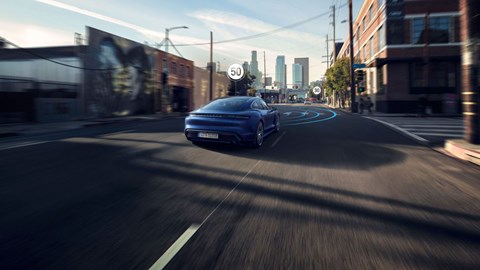
More tech
The improved tech gives prospective buyers plenty to get excited about; battery optimisation means the Taycan Turbo S can now hit 124mph in just 9.6 seconds – 0.2 seconds faster than before.
The 2021 Taycan will be able to intelligently throttle-down recharging when owners plan to take an extended break from driving. By reducing the rate from 270kW, for example, to 200kW, battery temperatures and overall battery service life can be increased.
New Intelligent charging functions also place Porsche's EV firmly at the centre of a home charging network. Porsche says the Taycan can now be charged via a home's solar array, and can even be used as a power guard to prevent overloading of domestic connections.
Plug & Charge also promises to be a useful feature for Taycan owners. Although only available at Ionity charging stations, the new feature enables owners to simply plug in without any irksome admin; payment is done automatically, with the car acting as authentication. It's available in mainland Europe now, and at the UK's Ionity stations next year.
The 2021 Taycan will be available with a head-up display, to minimise the time the driver's eyes are off the road – arguably essential when you consider the acceleration the Porsche is capable of. Smartlift, a geography-dependent suspension lift is also available, so the Taycan will automatically raise the chassis clear of speedbumps.
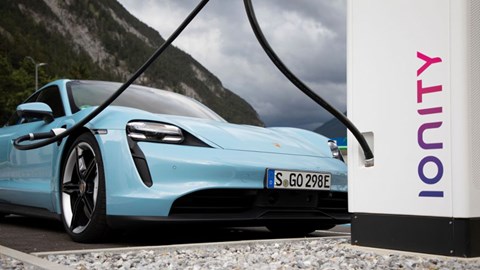
Functions on Demand
Speed-dependent power steering and adaptive cruise are new to the Taycan, but more innovative is the way Porsche will let you pay. Stuttgart has revealed a new Function on Demand service, which gives customers the option to pay monthly in some cases, or make a one-off payment.
The move, which was tried and withdrawn by BMW for Apple CarPlay, will see Porsche build every car with the necessary hardware built in, but require payment to unlock certain features. By standardising every car to a greater degree in this way, manufacturing costs should fall.
With that in mind, adaptive cruise will cost £18 a month, or a £759 in a single payment. Power Steering Plus will cost £299, with no monthly option.
Here's our full Porsche Taycan review
How much will a Taycan cost me?
UK pricing of the Taycan is as follows:
- Porsche Taycan 2£70,690,
- Porsche Taycan 4S£83,367
- Porsche Taycan Turbo £115,858
- Porsche Taycan Turbo S£138,826
Porsche Taycan: from Mission E to the road
The Taycan was unveiled at three co-ordinated events across the globe in Toronto, Berlin and Fuzhou in 2019. It premiered with range-topping Turbo models, and Porsche is gradually adding more affordable models below.
The 4S added a smaller-capacity battery, less power and a slightly smaller price tag than the toppy Turbo and Turbo S versions; the Taycan 4S costs just under £84k in the UK, excluding any grants.
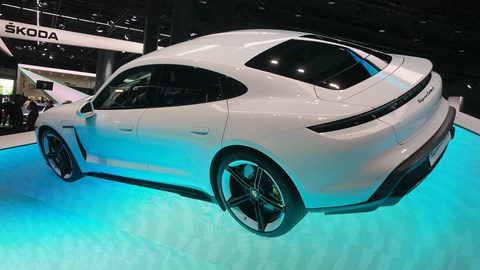
The Taycan is big news for Porsche. Chairman Oliver Blume wasn't over-cooking it when he said at the launch: 'This day is the start of a new era. The Taycan links our heritage to the future.'
The Mission E concept car of 2015 set the tone for the Taycan, and the production car retains its spirit remarkably faithfully. This is definitely A Good Thing.
Taycan: the design story
The Porsche Taycan is a touch shorter than a Panamera and keeps that familiar Coke bottle shape seen on the 911. Dimensions are:
- Length4963mm
- Width1966mm (2144mm with mirrors)
- Height1381mm
- Wheelbase2900mm
Compact headlights with quad-LED day-running lights are inset into the bulbous wheelarches at the front and the now-traditional lightbar at the rear. That's the simple stuff, but the devil's in the details.
There are active air vents with brake cooling in the front directing airflow where required, full underside protection, a flush rear spoiler and circuitry-like detailing behind the panel housing the 'Porsche' logo at the rear.
Porsche claims the Taycan has the lowest drag co-efficient of any of its cars, rated between 0.22 and 0.25Cd, depending on the model. The brand has even kept the option of white-rimmed alloys like the original Mission E concept car (see Storm Trooper spec Turbo S below).
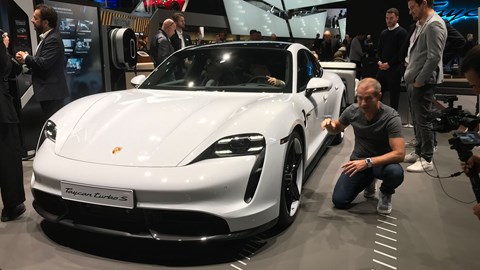
So how did Porsche get from Mission E concept car to full production Taycan? Porsche's chief designer, Michael Mauer, told CAR: 'If you would like to have an EV sports car which is defined by its proportions - with the battery pack in the floor and having people sit on top of it - I think you could say is a challenge or a headache.
'That was maybe one of the big challenges to stick to, and I think it's one of the biggest achievements to stick with the proportions.'
Taycan: performance figures
There's a motor on each axle on the Turbo and 4S models, a single-speed transmission on the front and a two-speed transmission at the rear for all-wheel drive. That two-speed transmission has a shorter gear designed for maximum power on launch starts and a longer gear for more regular driving.
Our pick of the best electric cars
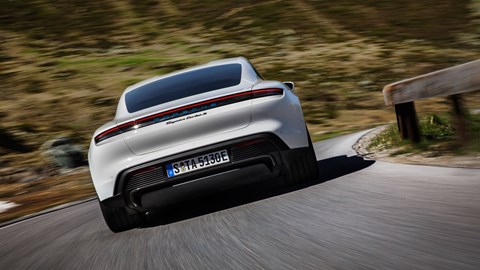
Both Turbo and Turbo S Taycans have 616bhp, with an overboost function for launch control resulting in 671bhp with 627lb ft, or 751bhp with 774lb ft respectively.
One of the main points Porsche wants to ram home is the repeatability of its launch control function – the car has been engineered to handle several hard launches without the risk of damaging the battery or other componentry.
Check out some of the clips on Youtube to see what this means; where other EVs' performance falls away after several hard starts, the Taycan just keeps on going.
We suspect that's a dig at Tesla's process of having to warm up the car first then warn the driver that launching it may affect future performance.
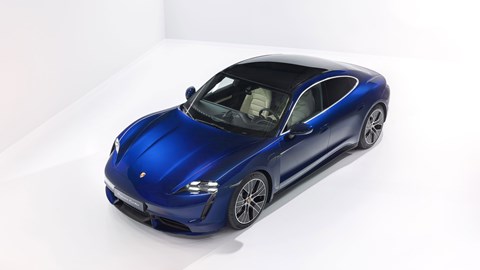
The Taycan has five drive modes: Range, Normal, Sport, Sport Plus and Individual. As expected, Range puts every conceivable part of the car that might consume e-power in its most energy-saving setting and remains in two-wheel drive unless required. In Sport and Sport Plus, launch control can be activated.
How far will each car go on one charge?
Porsche says the Turbo will do 280 miles on the WLTP cycle, while the more powerful Turbo S will need a charge after 256 miles. The 4S, meanwhile, claims a 252-mile or 287-mile range, depending on which battery you pick.
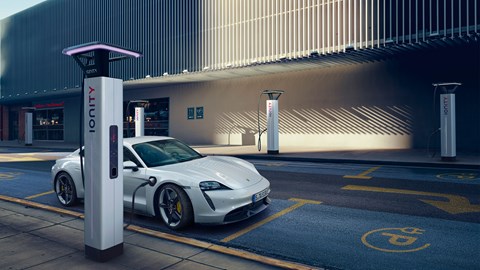
It's too early to call the range of the proposed 2wd Taycan, but with lighter weight and the smaller battery pack for a lower price, it will likely be a similar distance to its siblings.
What does a Taycan sound like?
Interestingly, Porsche has added something called Electric Sport Sound. EVs are meant to make some sort of noise at low speeds to meet safety laws around the world, but Porsche has played with the idea and introduced a noise as part of the Taycan package, standard on Turbo S.
Dr Manfred Harrer, Porsche's VP for chassis development, told us: 'It's hard to describe but it's not a combustion engine sound. You'll hear noise coming from the electric drivetrain – it's not designed to just make that louder, but it's similar to the original noise.' Expect a spaceship-like whoosh, then.
As for other performance car kit, we know a few details about what will be standard on the Turbo and Turbo S. The former will feature 20-inch wheels with Porsche's Surface Coated Brakes (discs are coated in silicon carbide) first introduced in the third-gen Cayenne nestled beneath them, air springs, 4D chassis control, torque vectoring and the brand's stability management programs. Go for the punchier Turbo S and ceramic brakes are standard, as are larger 21-inch rims, rear-wheel steering and a leather-free interior.
Onboard the new Porsche 935
How do you charge the new Porsche Taycan?
Porsche says its new EV is the first to use an 800v architecture for its power system, with most others using a 400v system. Stuttgart says this allows the Taycan to gain an extra 62 miles of charge in just five minutes on the most powerful chargers (if you can find one...).
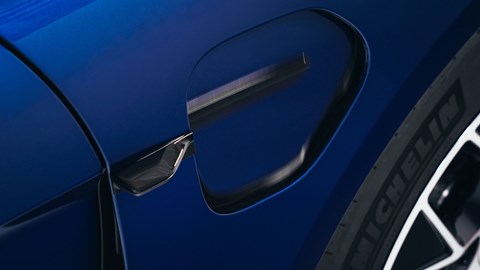
From 5% to 80% charge can be done in as little as 23 minutes on emerging 800v DC fast chargers. When you buy one, you get three years of access to IONITY chargers and the Porsche Charging Service, which allows for access to charge points from various operators. In Europe, the Taycan will come with Type 2 and CCS sockets for AC and DC charging respectively, with the Taycan able to handle up to 270kW of 800v DC charging, 150kW of 400v DC charging or 11kW of 240v AC home charging.
Porsche also has a 'charging planner' that reduces the effects of cold temperatures affecting the speed of charging, by pre-conditioning the batteries to an optimal temperature.
Under the skin of the Taycan EV
This car uses the new J1 platform that it will share with Audi's e-Tron GT car, which is also going to make the jump from concept car catwalk to production. It's not the last time we'll see the two brands work together; after these two sports saloons, we'll get the PPE platform.
'Porsche is working with its VW stablemate on a separate platform called the Premium Performance Electric or PPE,' said Stefan Weckbach, head of BEV at Porsche. 'E-mobility is a Herculean task, and that's also true in monetary terms. Group-wide cooperation is therefore a huge plus for us.
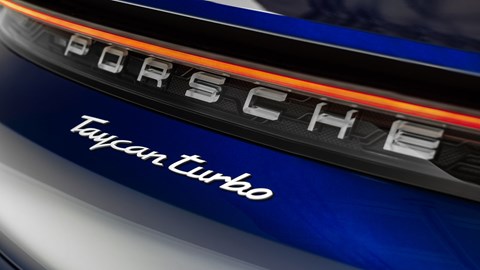
'We're working very closely with our counterparts, in particular at Audi, on the use of joint modules for the e-vehicles we are currently planning. The brands are also working on the joint development of a platform for new BEV [battery electric vehicle] projects in the future.'
We should expect three SUV or saloon models from that architecture in the future, enabled by the economies of scale sparked by working with sister brands. By teaming up, Audi and Porsche are jointly saving 30% in R&D costs, Weckbach added.
What are supercapacitors? All you need to know about the next step for EVs and hybrids
Inside the interior of the Porsche Taycan
Like the new 992-generation 911's interior, the Taycan's is a clean, uncluttered space that artfully marries tech and tranquillity. 'The cabin design, with its strong horizontal elements, accentuates the width of the car, just like the 992, while the driver's view is dominated by the stunning, hood-less 16.8-inch driver display,' says Taycan director Robert Meier.
Perhaps sensing the need to soften the electric pill with plenty of comforting, nostalgic sugar, there's a deliberate timelessness to the Taycan's interior, despite the cutting-edge tech. If you like the inside of the new 911 – and let's face it, most of us do – you'll love this.
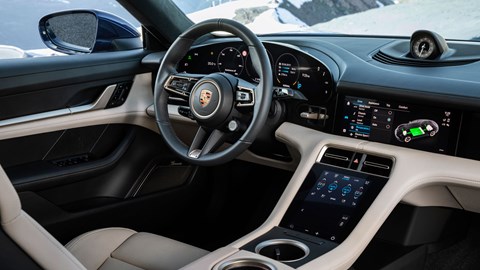
At the same time the driving position is endearingly sporty for a zero-emission EV. 'We have a similar driving position to the 911's, though a little higher because of the battery underneath,' explains director of platform Bernd Propfe.
There may not be a flat-six to fire up, but slide behind the Taycan's steering wheel and you feel ready for every ounce of its performance and grip – however outlandish they might be…
Not all that long ago, the Panamera's centre console was a mess of buttons. The new PanAm did away with that, and inspired the new 911's similarly uncluttered cockpit and trick driver's display, which flank an old-school analogue rev counter with floating glass displays.
The Taycan takes that floating glass concept to the next level: the whole instrument panel is a single floating glass display with touch control. There's no frame and the glass doesn't hide under a traditional instrument hood, either, with Porsche claiming its new screen technology means display visibility isn't compromised by bright or direct sunlight. As part of this purging of interior clutter, Porsche's stubby drive selector – which sits where you'd expect to find the gearlever in the 911 – is up next to the steering wheel, and an easy reach for your right hand. There's also a power button instead of the usual ignition or start/stop button – because this is an electrical device.
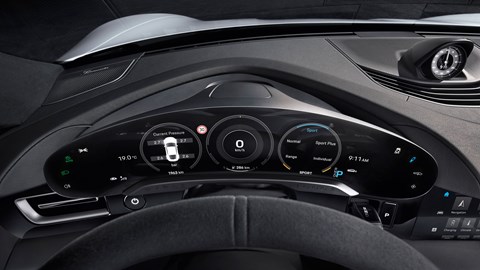
The Range Rover Velar introduced Touch Pro Duo, with all climate and ventilation functions controlled via a second, lower touchscreen. Taycan does the same, while also adding a touch pad with which you can interact the main infotainment screen more comfortably, without having to lean forward and prod at the dashboard.
Tick the box and your Taycan boasts a second infotainment touchscreen on the passenger side. Now your buddy can become co-pilot, inputting new nav commands or checking out upcoming charger locations without corrupting your infotainment display. Or they can just watch The Killingagain. You can't watch movies on the motorway when you're in the car on your own: if the passenger seat's empty, the passenger screen is rendered inactive. Probably for the best.
They did say it was a four-seater…
The 911 has rear seats but Porsche's rear-engined icon isn't a four-seater by any stretch of the imagination. The Taycan is (Porsche calls it a four-door, five-seat C-segment saloon), not least because the electric saloon's a bigger car. While Porsche is at pains to point out the 911 inspiration in the electric car's ergonomics and silhouette, the Taycan's closer to the Panamera on size: 4963mm long (with a 2900mm wheelbase), 1966mm wide and just 1378mm high.
Rear-seat passengers get decent headroom, despite the coupe-like roofline, while spaces in the underfloor battery for the footwells give a comfortable seating position while maintaining battery volume and capacity. There are also two luggage areas – one at the front with 81 litres and 366 litres at the rear.
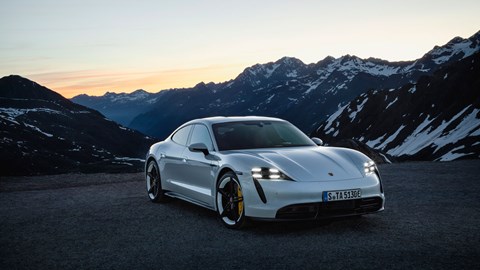
Want to buy one? Demand is high
It's just as well Porsche is on course to deliver the car at the start of 2020, because demand is high. Chairman Blume said at the launch of the Cayenne Coupe that 20,000 prospective owners had placed deposits of €2500 each to secure their place in the queue. 'That's incredible since they have neither seen it nor driven it,' he told us. 'Deposits are refundable if customers decide to pull out.'
However, since the car made its official debut, Taycan deposits are up to around 30,000 according to Porsche's Deputy Chairman, Lutz Meschke.
It seems that the new Porsche Taycan will be in hot demand and Blume admitted that the company had underestimated the level of interest in the EV. He said they had originally conceived a 20,000-annual volume, but that they were revisiting these figures now.
Where is Porsche going to build its electric car?
The new Taycan will be built in Porsche's Zuffenhausen plant, alongside the 911 – but with space and time at a premium, the extra facilities needed for the Taycan are being built around the existing, working factory. More than 1200 jobs will be created by the new car.
According to a German newspaper, Porsche has doubled its production targets for the new EV, so around 40,000 Taycans should be leaving the factory each year. That should give Stuttgart ample return on its recent €700 million (£607m) investment on the site.
Further electric car reading:
The best electric cars and EVs on sale today
How much does it cost to charge an electric car?
The best hybrids, plug-ins and PHEVs
The Audi e-Tron GT revealed
Source: https://www.carmagazine.co.uk/car-news/first-official-pictures/porsche/taycan/

Tidak ada komentar: